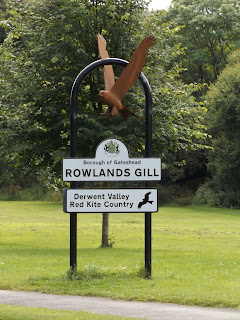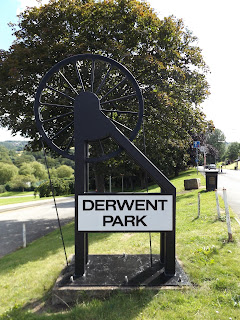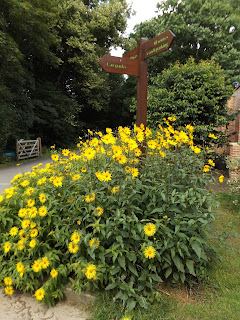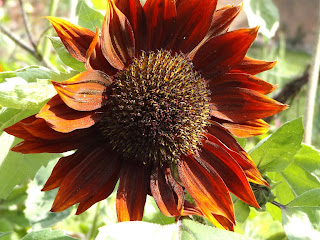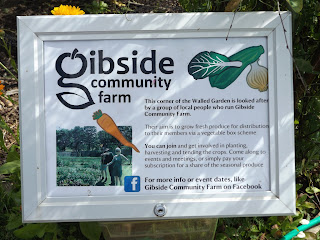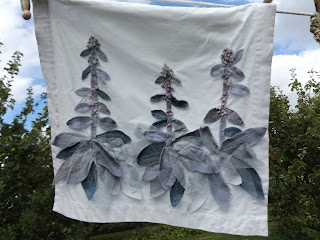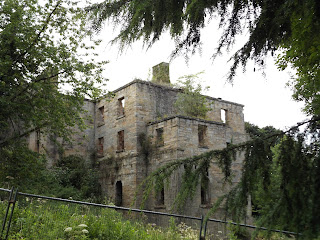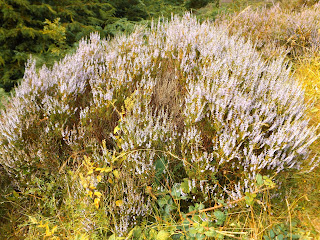Gibside
The Blakiston family acquired the estate by marriage in about 1540. Sir William Blakiston (1562–1641) replaced the old house with a spacious mansion between 1603 and 1620. Both the Royal (King James I of England) coat of arms and the Blakiston coat of arms are seen over the entrance of the old Hall.[1] The Gibside property came into the possession of the Bowes family in 1713; a result of the marriage between Sir William's great granddaughter, Elizabeth Blakiston, to Sir William Bowes (1657–1707) of Streatlam Castle(now demolished) in 1693.[2]
Until 1722,[3] the basis of the Bowes' influence was their own estate and castle of Streatlam. However after that date, the acquisition through marriage of the Blakiston estate gave the Bowes family an even greater influence in the north of the county and a share in the immense wealth that was to be acquired from the coal trade. The Blakiston estate included some of the area's richest coal seams.[4]
In 1767, the granddaughter of Sir William Bowes – the "Bowes heiress" Mary Eleanor Bowes – married John Lyon, 9th Earl of Strathmore and Kinghorne, who changed his surname to Bowes due to a provision in her father's will that any suitor had to take the family name. This was a device to continue the Bowes lineage in the absence of a male heir. Improvements to Gibside carried out by the Bowes-Lyon family included landscaping in the 18th century, a chapel (Gibside Chapel, built between 1760 and 1812), a banqueting hall, a column of Liberty, an avenue of oaks and several hundred acres of forest.
Queen Elizabeth The Queen Mother – a direct descendent of Sir William Blakiston and thus the great great great granddaughter of Mary Eleanor Bowes – had fond memories of Gibside. During her youth, she had enjoyed trips with her father, Claude Bowes-Lyon, 14th Earl of Strathmore and Kinghorne to the estate, which was owned by her family.[6] Both she and her husband, the Duke of York (later King George VI), visited the estate a number of times, the first time in July 1936[7] and the last being in 1968 when, as the Queen Mother, she made a private visit to the Gibside Chapel.
the direct ancestor of Catherine, Duchess of Cambridge, was Sir Thomas Blakiston Conyers, 9th Baronet (d.1810), who was the great great great grandson of Sir William Blakiston (d.1641) of Gibside. The Duchess and the Queen Mother - the great great great granddaughter of Mary Eleanor Bowes - are thus distant blood cousins; their common ancestor being Sir William Blakiston.
The chapel
Replica of Sir George Bower daughter's
Mary Eleanor Bowes's wedding dress
Sits for the Bowes Family
George Bowes inherited the family estates in 1721—although he was the youngest son, his elder brothers died young. In October 1724 he married the fourteen-year-old Eleanor Verney, but she died in December of that year. Her death was commemorated in a poem, written by Lady Mary Wortley Montagu, which implied that she had died as a result of Bowes' sexual vigour.[1]
Bowes went on to marry Mary Gilbert in 1743 and had one daughter, Mary Eleanor Bowes, born 24 February 1748 (old style)/1749 (new style). She married John Lyon, 9th Earl of Strathmore and Kinghorne, who later took the name "Bowes", as a condition of the will of George Bowes, in order to inherit the Bowes estate.[2] They formed the Bowes-Lyon family, one of whose descendants was the late Elizabeth Bowes-Lyon, known in Britain as The Queen Mother. Hence, George Bowes would be the present Queen Elizabeth II's great-great-great-great-great-grandfather.
Bowes was for some years the Member of Parliament for County Durham and he was rich and influential, largely on account of the coal which lay beneath his estates. In 1726 he was a founder of the Grand Alliance of coal owners, a cartel for the control of the London coal trade.
George Bowes' principal residence was Gibside, a mansion on the banks of the River Derwent, in County Durham. The surrounding park was laid out by Lancelot "Capability" Brown and includes a column, 140 feet high, dedicated to British liberty. On George Bowes death, Gibside passed to his son-in-law, the ninth Earl of Strathmore, who built a chapel in the grounds, in Palladian style, as a mausoleum, in which Bowes was finally interred, when it was completed it in 1812.
Sits for the Servant
John Bowes, the illegitimate son of 10th Erl. As his mother was not from the high society wasn't really accepted, and had inherited his father's wealth but not his title moved to France where met his wife Joséphine Chevalier. There he collected much artworks. Later on they moved to England. The Bowes Museum was purpose-built as a public art gallery for John Bowes and his wife Joséphine Chevalier, Countess of Montalbo, who both died before it opened in 1892.
The Bowes Museum has a nationally-renowned art collection and is situated in the town of Barnard Castle, Teesdale, County Durham, England.
The museum contains paintings by El Greco, Francisco Goya, Canaletto, Jean-Honoré Fragonard and François Boucher, together with a sizable collection of decorative art, ceramics, textiles, tapestries, clocks and costumes, as well as older items from local history. The early works of French glassmaker Émile Gallé were commissioned by Joséphine,
The Chapel was built between 1760 and 1812
Crypt under the chapel
Ale
The walled garden
The exhibition in the garden
The bees of Gibside garden
The Theater
More flowers
The Orangery
The Ice House
The ruins of |Gibside Hall
The Liberty Statue
Liberty Staue on the left - Gibside Hall on the right
Climbing up to the statue
Liberty Statue
Liberty Statue
The Lily Pond from the statue
Lily Pond
A friendly resident
The Octagon Pond
The banqueting House above the Octagon Pond
The Stables - by the time I have arrived
unfortunately it was already closed




